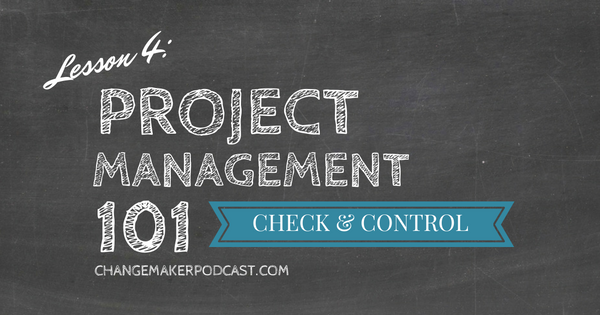Get more good stuff.

The Check and Control phase spans the entire project (with the majority of focus spent during the Execute phase). In this phase, we’ll discuss how to monitor project health and 10 ways to get a troubled project back on track.
This is the fourth of the 5-post series describing how to manage a project. The 5 key steps to managing a project are:
- Idea Approval – What do you want to do? Why?
- Plan – How are you going to do it?
- Execute – Let’s get it done!
- Check and Control – Keep the project on track.
- Close – Wrap up the project.
Check & Control – Keep the Project on Track
Check
Planned Vs. Actual
Monitoring your scope, schedule, budget, and work performed involves comparing planned performance with actual performance and taking action when there are differences between them.
It’s important to use all of these pieces when determining if a project is on track.
Let’s say a project was scheduled to take 3 months and cost $12,000. After 1.5 months, $6000 was spent. Things seem like they’re going well and the project is 50% complete, right? Not exactly since we’re missing a key piece – the work that was actually performed.
It’s possible that only 25% of the project work was completed in that timeframe and with that cost, which would mean the project isn’t doing well. Alternately, it’s possible that 75% of the project work was done, and the project is under budget and ahead of schedule.
Trends
In addition to comparing planned performance with actual performance, trends need to be monitored to be certain the project is on track.
Does the same issue keep occurring? Are tasks getting more delayed as time goes on? Are the costs less than initially planned? Is certain work getting done faster than expected?
Trends can help to forecast where the project may be heading and can help us to identify persistent issues (and opportunities).
Core Project Metrics:
 Monitor these core pieces throughout the project and watch for signals that the project may be slipping:
Monitor these core pieces throughout the project and watch for signals that the project may be slipping:
- Scope – is work being done on only the approved scope and requirements?
- Schedule – ahead, delayed, on time?
- Budget – under, over, within budget?
- Work – how much work has been completed?
- Quality – are the deliverables meeting quality expectations?
- Issues – number increasing / decreasing? pattern of recurrence? resolved in a timely manner?
- Rework – number of tasks that need to go back a step (e.g. website designer missed adding a button, tester caught it and sent it back to the designer for rework)
- Stakeholder Satisfaction – are stakeholders’ expectations being met?
These metrics can be gathered through regular status updates, observation, and communication.
How Frequently Should You Monitor
You’ll want to avoid “analysis paralysis” or focusing too much time on collecting and evaluating data. Use the core metrics and keep things simple.
Request regular status updates from your team no more than weekly. Additionally, review the data you’ve collected to see if there is anything signaling that the project is or could be heading off track.
Baselines
At major milestones, conduct a project baseline. Baselines are like gates that only open when there is agreement to proceed. This reduces some risk as the project is evaluated at key phases prior to investing additional time, money, and people.
For example, a baseline occurs when the project idea is reviewed. The stakeholders look at all of the information and determine if the project should move forward. If yes, the project can officially move past that gate into the Plan phase.
Control
10 Ways to Get a Project Back on Track
When you learn that your project is off track, start by asking “why” and determine the root cause.
Work with your team to determine the best path for preventing the same issue from occurring and getting the project back on track. Consider first the solutions that can be done without negatively impacting the project scope, quality, deadline, or budget.
1. Contingency
Look at your project schedule to see if there is contingency available to use for this situation. Deduct the time and costs you need from the contingency, but keep the overall project on track (yay for risk planning!).
2. Verify Dependencies
Focus on the critical path and verify that dependencies are real. When building a house, you may have a task that the bathtub must be installed before tiling the bathroom floor. After discussing this further with your team, you may determine that this isn’t a real dependency and that the tiling can occur before the tub is installed.
3. Perform Tasks Differently
Again looking at critical path tasks, determine if a task can be done differently to save time.
Let’s say a signature is scheduled to take 3 days. Signing a document takes seconds, but it may take a key stakeholder longer to find time to review the document during their busy schedule. This task could be sped up by setting up a review meeting with the stakeholder and capturing the signature during the meeting.
4. Improve processes
Think of ways to improve processes in order to reduce the amount of waste in your project.
Your team may be spending a lot of time performing rework. Reducing rework could be as simple as using a checklist to ensure key pieces are correct before passing the deliverable on to the next person.
5. Work Overtime
This is not a team favorite, but overtime can be an option if used sparingly. Consider how this may increase costs if you are working with a contract or hourly employee.
6. Reallocate Resources
You may choose to have a team member temporarily pause on their current task to assist with the critical task. This will cause the work on their original task to be delayed, so consider how that will impact and possibly change the critical path.
This option works best when people working on non-critical path tasks are assigned to help on critical path tasks.
7. Fast-Tracking
Fast-tracking compresses a schedule by changing tasks from being sequential (e.g. Task B can only start after Task A is finished) to being done in parallel (e.g. Task A and Task B are worked on at the same time).
Let’s say the shopping cart functionality for our travel website is scheduled to begin after the design is complete. With fast-tracking, we may decide to build the shopping cart at the same time as the design is being drafted. Be aware that this introduces a risk – it could offer a time savings if the design doesn’t change much or it could cause more issues if the design frequently changes, therefore requiring the shopping cart functionality to change.
8. Swap Team Members
After spending some time on the project you may determine that certain team members are not a good fit. It may be beneficial to swap someone on your team for another person that has the expertise the project needs to succeed.
9. Crashing
Crashing involves adding more people to the project. This usually results in a higher cost so should only be utilized when the Change Review Board approves of the budget change.
Keep in mind that this works better for some tasks and not as well for others. It reminds me of the saying, “it takes 1 woman 9 months to make a baby, but 9 women can’t make a baby in 1 month.”
10. Formal Change
It may be necessary to re-plan the project and request a formal change to the scope, schedule, or budget. This will require approval from key stakeholders.
If a re-plan is being considered, aim to do this only once. Evaluate the entire remainder of the project and re-plan with the whole picture in mind. Your credibility will suffer if you continue to ask for re-plans.
Communicating to Stakeholders
Stakeholders should already be receiving regular status updates from you. Include this issue within your regular communications. Depending on the urgency, you may need to communicate more frequently and / or in-person.
Prior to any formal communication, do the following:
- Understand the issue well and make sure it’s really an issue.
- Have a plan to address the issue and get the project back on track.
- If you need to communicate the issue, but don’t yet have enough time to put a solid plan together, determine the date that you’ll have a plan.
- Know what you need. Stakeholders are interested in the project’s success. Ask for and use their help when you need it.
That wraps up the Check and Control phase. Hopefully this information can help you to get through sticky situations and keep your projects on track!
 Important Tips
Important Tips
I’ve made a lot of mistakes while managing projects and I want to help you avoid making the same ones. Here are some additional tips that will save you major headaches:
Accelerators Are Your Friend
Much of this post was about how to identify issues and get your project out of trouble. While monitoring your project, also look for the patterns and trends that give a boost or accelerate your project.
Try to set up similar scenarios going forward that encourage these accelerators to happen again.
For example, you may notice that someone is performing the same task a lot quicker than another person. After asking “why” and finding the root cause, you may determine that they use a certain technique that was unknown by the rest of the team. Now this technique can be utilized by others and help to accelerate your project even further!
